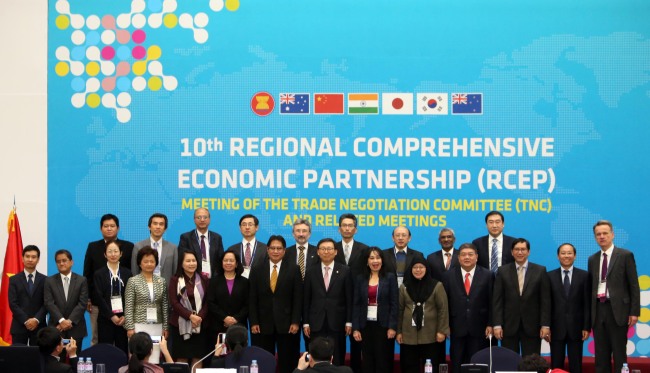A new round of negotiations for a free trade pact linking 16 nations across Asia and Oceania has taken off in South Korea with a fresh sense of urgency, following the conclusion of the U.S.-led Trans-Pacific Partnership last week.
The 10th round of talks on the Regional Comprehensive Economic Partnership kicked off in Busan on Monday, with some 700 officials from the 16 countries in attendance. The talks will conclude Friday.
RCEP is an envisioned free trade agreement involving the 10 members of the Association of Southeast Asian Nations and their six current FTA partners — Australia, China, India, Japan, Korea and New Zealand.
“Led by a high economic growth rate and a young and dynamic population, I am very much confident that this new economic bloc will develop into a growth engine for the global economy,” said Moon Jae-do, vice minister at Korea’s Ministry of Trade, Industry and Commerce on Monday.
The 16 participating states account for nearly 30 percent of the world’s population and contribute to about one-third of the world’s gross domestic product with a trade volume of around $10.6 trillion, according to the Korean Trade Ministry.
The ongoing RCEP negotiations are focused on setting up comprehensive guidelines for market access and liberalization under the mega free trade pact and selecting the list of sectors to be liberalized in each country.
As the U.S.-driven TPP reached a historic conclusion in Atlanta last week, industry watchers say the participating states, particularly those left out of the TPP, may be feeling a new sense of urgency to make more meaningful progress in the RCEP negotiations.
“The recent passage of the TPP may have stimulated the RCEP members to accelerate progress on the trade deal,” said Suh Jin-kyo, executive director of the department of international trade at the Korea Institute for International Economic Policy.
“As the host of the latest round of talks, South Korea also may hold a higher chance of successfully urging the participants to take a major step toward concluding the mega trade pact,” he said.
Though the 16 countries are planning to seal the RCEP trade pact in a summit in November, the KIEP official said it is unlikely that a meaningful conclusion will be reached in the near future given the current speed and status of the negotiations.
“Though the level of market liberalization being pursued by the RCEP is similar to that of the TPP, current progress on RCEP falls far short of the U.S.-backed TPP due to diverging interests,” Suh said.
Unlike the 12-way TPP, RCEP involves not only advanced economies like China, Japan and Korea but also four less developed economies including Cambodia, Laos, Myanmar and Vietnam.
“Even as RCEP seeks to pursue a high level of market liberalization, it has to offer more flexibility and lower standards to the less developed countries, making it difficult by nature for RCEP to reach a status equaling that of the TPP,” he said.
Nonetheless, Seoul may reap many benefits from its participation in the RCEP, as the 16-way FTA will establish strengthened ties with ASEAN — one of Korea’s vital trade partners — and build up an expanded version of the China-Korea-Japan FTA, according to the KIEP director.


